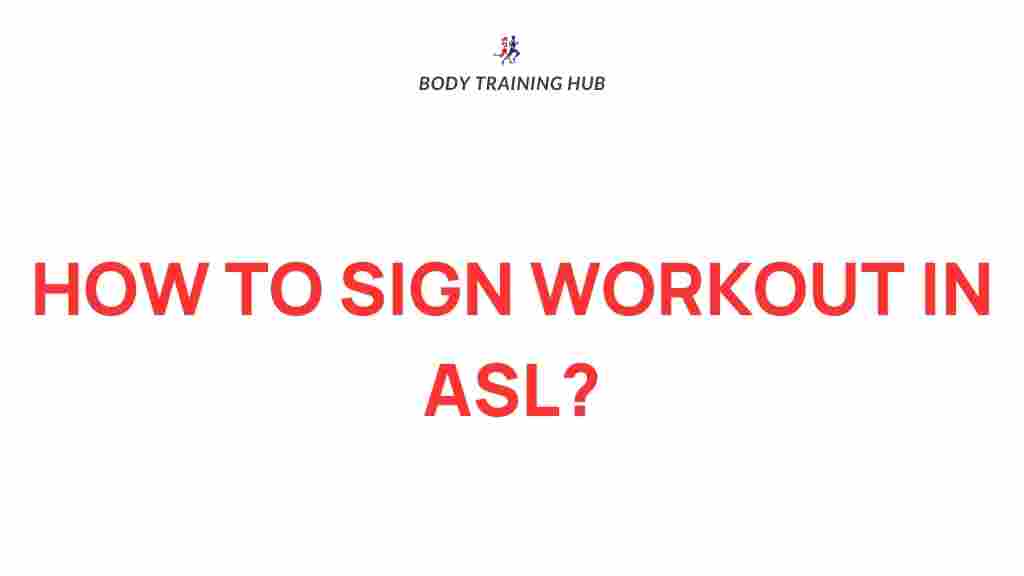Unraveling the Mystery of ASL Workout Signs
In the world of fitness, communication is key. For those who are deaf or hard of hearing, American Sign Language (ASL) provides an essential means of communication during workouts and physical activities. Understanding ASL workout signs not only enhances the workout experience for individuals who use this language but also fosters inclusivity within fitness communities. In this article, we’ll delve into the significance of ASL workout signs, explore various signs used in fitness, and provide tips on how to incorporate them into your exercise routine.
The Importance of ASL in Fitness
As fitness enthusiasts, we know that staying active is crucial for maintaining good health. However, effective communication during workouts can be a challenge for those who use ASL. By learning ASL workout signs, fitness instructors and fellow gym-goers can create a more inclusive environment, allowing everyone to participate fully in physical activity. Here are some key reasons why ASL is vital in fitness:
- Enhanced Communication: Clear communication ensures that all participants understand workout instructions, safety tips, and exercise techniques.
- Inclusion: Learning ASL workout signs fosters a welcoming atmosphere for individuals who are deaf or hard of hearing.
- Improved Safety: Effective communication helps prevent accidents and injuries during exercises by ensuring that everyone is on the same page.
- Community Building: Understanding ASL allows for the creation of a supportive community where everyone feels valued and included.
Common ASL Workout Signs
Now that we understand the importance of ASL in fitness, let’s explore some common ASL workout signs that can be used during exercise sessions. These signs represent various physical activities and fitness-related terms:
- Exercise: The sign for exercise involves placing your hands in front of your chest and moving them outward as if pushing against resistance.
- Run: To sign “run,” extend your hands in front of you with the palms facing down, then move them forward in a running motion.
- Lift: For lifting weights, raise your hands upward as if you are lifting something heavy.
- Stretch: To indicate stretching, reach your arms overhead and lean to one side, then the other.
- Yoga: The sign for yoga involves making a circular motion with your hands, representing fluid movements.
These signs can be easily incorporated into workout routines, making it simpler for everyone to understand and engage in the exercise at hand.
Step-by-Step Process: Learning ASL Workout Signs
Learning ASL workout signs can be a fun and rewarding process. Here’s a step-by-step guide to help you get started:
Step 1: Research and Resources
Begin by researching available resources. Websites, apps, and community classes focused on ASL can be great starting points. Consider checking out ASL Pro for video tutorials on various signs.
Step 2: Practice with a Partner
Find a friend or a fellow fitness enthusiast who is interested in learning ASL. Practicing together can help reinforce your learning and make it more enjoyable.
Step 3: Use Visual Aids
Utilize visual aids such as flashcards or posters that depict ASL workout signs. Having these materials accessible can help you memorize the signs more quickly.
Step 4: Incorporate Signs into Workouts
Start using ASL signs during your workouts. Whether you’re in a group fitness class or exercising solo, try to integrate the signs into your communication.
Step 5: Attend ASL Classes
Consider enrolling in an ASL class, especially one focused on fitness terminology. This structured learning environment can significantly enhance your understanding of ASL.
Troubleshooting Tips for Using ASL Workout Signs
Learning ASL workout signs can come with its challenges. Here are some troubleshooting tips to help you navigate common issues:
- Confusion with Signs: If you’re unsure about a specific sign, don’t hesitate to ask for clarification. Most people will appreciate your effort to communicate effectively.
- Speed of Communication: It may take time to get used to the speed of ASL. Practice regularly to become more fluent in signing.
- Non-Verbal Cues: Remember that ASL is not just about the signs; facial expressions and body language are also crucial for conveying meaning.
- Patience: Be patient with yourself and others as you learn. Mistakes are a part of the learning process.
Conclusion
As we have explored, ASL workout signs play a vital role in promoting effective communication within fitness environments. By learning and utilizing these signs, we can create a more inclusive atmosphere that values all individuals, regardless of their hearing ability. Whether you are a fitness instructor, a gym-goer, or someone who wants to promote health and physical activity, understanding ASL can greatly enhance your experience and the experience of those around you.
Incorporate ASL into your workout routine, practice regularly, and encourage others to join in this essential communication effort. Together, we can ensure that fitness is accessible to everyone. For more information on ASL and its significance in various contexts, you can visit the National Association of the Deaf.
Remember, fitness is not just about physical activity; it’s also about connection, communication, and community. Let’s work together to make fitness a space where everyone feels welcome and empowered!
This article is in the category Training Guides and created by BodyTraining Team
